The rat snake is one of the most popular types of pet snake in America.
They are great for beginners due to their docile personality and simple care needs.
In total there are over 45 known species of rat snakes that are divided into two main categories.
Old world species are from Europe and new world species are from North America. New world species are more tame and easier to handle so they are better for beginners.
Keep reading to learn which species make the best pets.
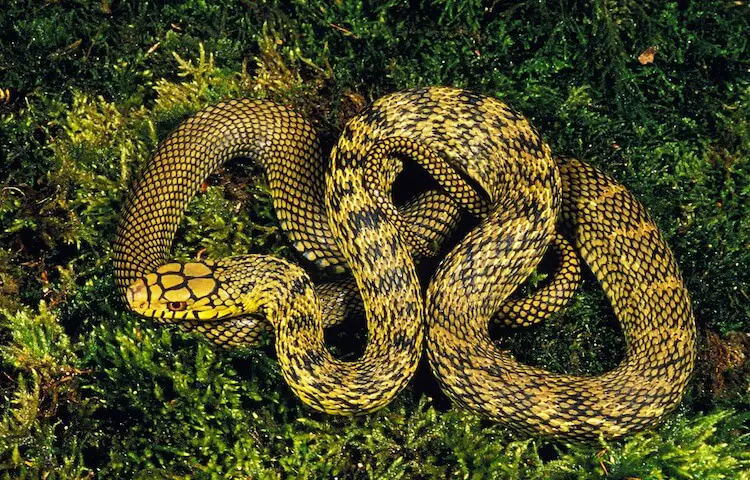
What Is A Rat Snake?
Rat snakes are nonvenomous medium-sized constrictor snakes.
These snakes are a member of the Colubrid family so are related to:
- Garter snakes.
- Grass snakes.
- Racers.
- Whipsnakes.
Rat snakes range in size from two to ten feet depending on the species.
They also vary widely in color and pattern.
Some species are a single color (e.g. black and yellow varieties) and others have color and pattern complexity (e.g. Ridley’s Cave-Dwelling).
It is not uncommon to find stripes, bands, spots and saddles on a rat snake.
Some species have ridged scales to help them climb. Others have completely smooth and glossy scales for swimming.
There are over 45 known species of rat snake that have great color, pattern and size diversity.
Below is a list of the best 20 pet species and what they look like…
Top 20 Rat Snakes By Popularity
20. Tiger
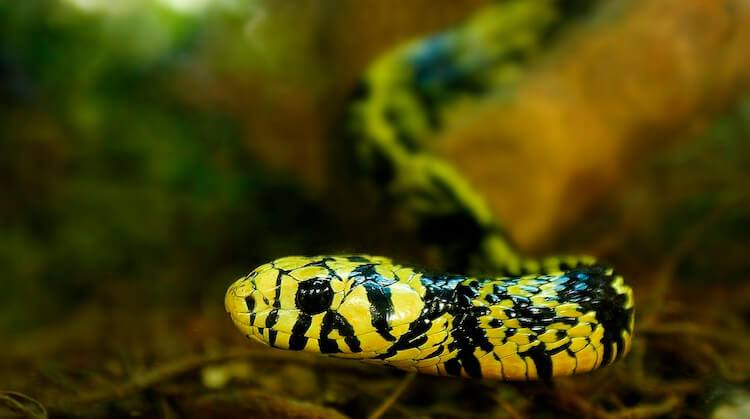
Tiger rats are one of the largest pet snakes in North and South America and reach an average length of nearly ten feet.
This new world species lives in southern Mexico, Peru and parts of Brazil.
Tiger rat snakes are creamy yellow with a black pattern. This black pattern can be either bands, webs or stripes that fade to a dark red or completely black tail.
They also have a series of black stripes on their face that gives them a tiger-like appearance.
Despite their name tiger individuals are docile and can make wonderful pets.
| Vital Facts |
|---|
| Color: Yellow with a black tail |
| Pattern: Black stripes or bands |
| Size: 5 to 10 feet |
| Classification: New world |
| Scientific Name: Spiloted pullatus |
19. Ridley’s Cave-Dweller
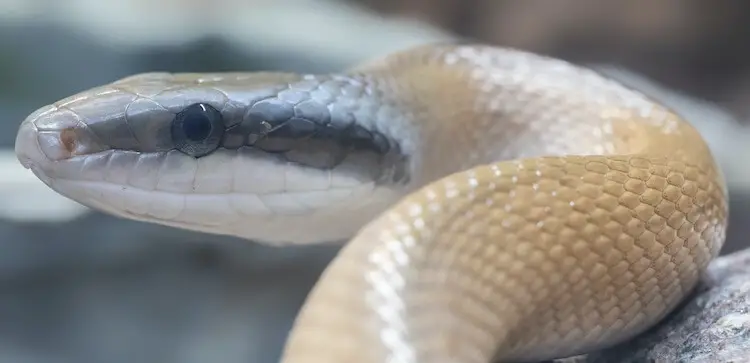
The Ridley’s Cave-Dweller is native to Malaysia and Thailand where it lives in caves and eats bats.
This rat snake is also called a beauty snake.
They have a lavender head that fades into an orange body. Their orange body then fades into a black tail.
Ridley’s Cave-Dwellers have a single cream stripe down their spine and a pure white underbelly.
This rat snake’s unique colors have made it popular with collectors so it is very rare to find at most pet stores.
| Vital Facts |
|---|
| Color: Lavender to orange to black gradient with cream belly |
| Pattern: White dorsal stripe |
| Size: 5 to 7 feet |
| Classification: Old world |
| Scientific Name: Elaphe taeniura ridleyi |
18. Red-Tailed Green Rat
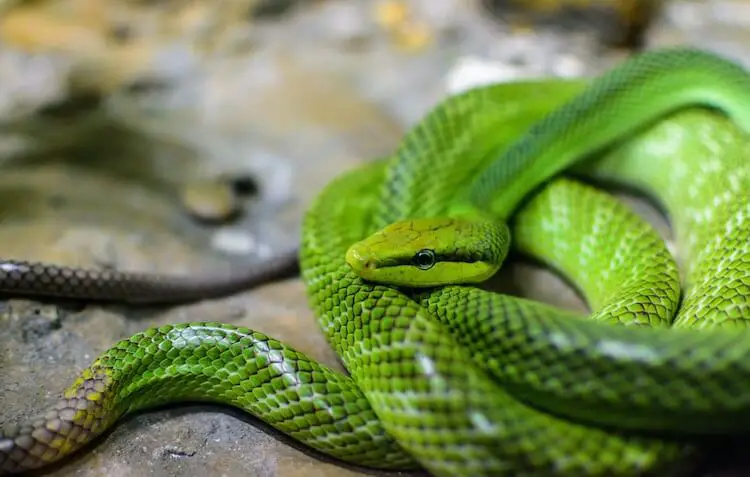
This large rat snake is a powerful constrictor that is native to southeast Asia.
Red-Tailed Green Rat Snakes are named after their red tail. They are also loved for their shiny bright green color and black skin.
Many individuals also have a light green zig-zag pattern down their bodies.
Their heads are light green or yellow with a black stripe through their eye. Some individuals have a bright blue tongue too.
Red-Tailed Green Rat Snakes are more aggressive than many species on this list. They should only be kept by experienced owners.
When threatened they puff up their bodies and appear nearly twice as big as their actual size.
| Vital Facts |
|---|
| Color: Bright green body, pale green belly and a red or brown tail |
| Pattern: Faint zig-zag lines |
| Size: 5 to 8 feet |
| Classification: Old world |
| Scientific Name: Gonyosoma oxycephalum |
17. Rhino Rat Snake
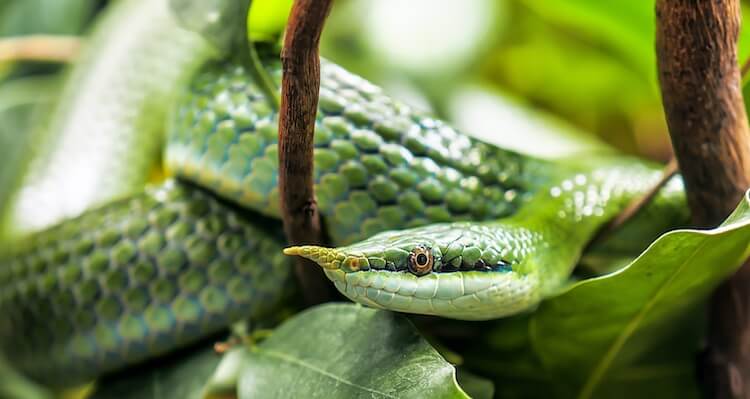
The rhinoceros rat snake is a unique species with a scaled horn on the end of its snout.
Newly hatched rhino snakes are a uniform gray-green with a pale cream underbelly.
As they age most individuals become bright green with a light yellow-green belly. However, some snakes retain their juvenile gray color.
No matter their age all species have a dark smudge from the tip of their snout through the eye.
Rhino snakes are commonly found and can be purchased for $200 to $300.
| Vital Facts |
|---|
| Color: Bright green back and sides and a light green belly |
| Pattern: Speckling |
| Size: 3 to 5 feet |
| Classification: Old world |
| Scientific Name: Rhynchophis boulengeri |
16. King Rat Snake

The King variety is a big snake that preys on venomous snakes.
King Rat Snakes have a large range throughout China and Vietnam and eat many species of venomous snakes.
The king rat snake is black with yellow scales and has a pattern of thin yellow bands around its midsection that fade toward the tail.
Their body scales are thickly keeled that give them a jeweled appearance.
Its head is yellow with black rings around the edges of the scales and its underbelly is olive with irregular black patches.
| Vital Facts |
|---|
| Color: Black yellow keeled scales |
| Pattern: Thin irregular yellow bands |
| Size: 5 to 7 feet |
| Classification: Old world |
| Scientific Name: Elaphe carinata |
15. Mexican
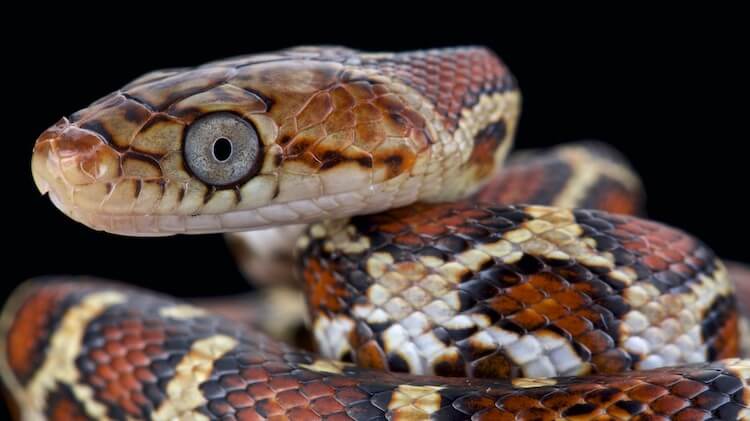
This species of rat snake is commonly found in Mexico and Central America.
Mexican Rat Snakes are very similar to corn snakes in appearance.
They are a beige color with dark red spots. These spots are ringed with black and occasionally blend together into a single wavy stripe. Because of this they are also called the yellow-red rat snake.
The sides of this snake also show red spots that alternate with the dorsal spots.
Their belly is white with few to no markings.
Mexican varieties have unique pale blue irises and small round pupils. They always appear startled.
| Vital Facts |
|---|
| Color: Beige and a cream under |
| Pattern: Black-ringed red spots |
| Size: 2 to 4 feet |
| Classification: New world |
| Scientific Name: Pseudelaphe flavirufa |
14. Mandarin
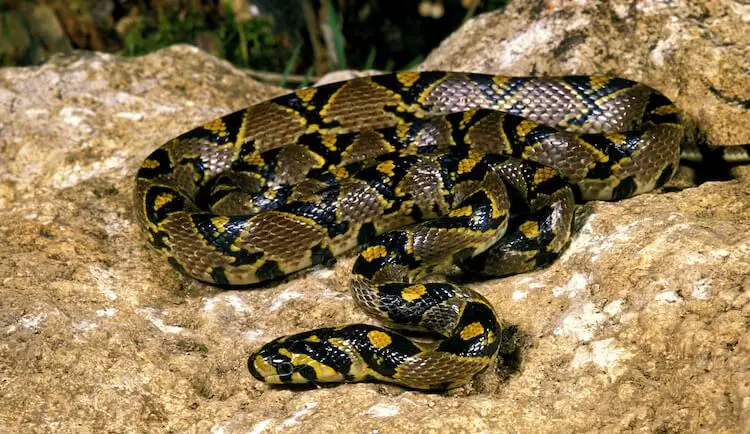
The Mandarin rat snake is native to India, Vietnam, Tibet and China (central and eastern Asia).
Unlike most rat snakes they rarely climb.
Instead mandarin snakes spend most of their time sheltering in empty burrows or searching for rodents on the forest floor.
They have tan colored bodies and are patterned with black and yellow diamonds along their back.
Their head is yellow with black bands and their belly is light beige with horizontal black stripes.
Mandarin Rat Snakes are very popular and some individuals cost over $300.
| Vital Facts |
|---|
| Color: Tan |
| Pattern: Black and yellow diamonds, black stripes on belly |
| Size: 4 to 7 feet |
| Classification: Old world |
| Scientific Name: Euprepiophis mandarinus |
13. Leucistic Texas
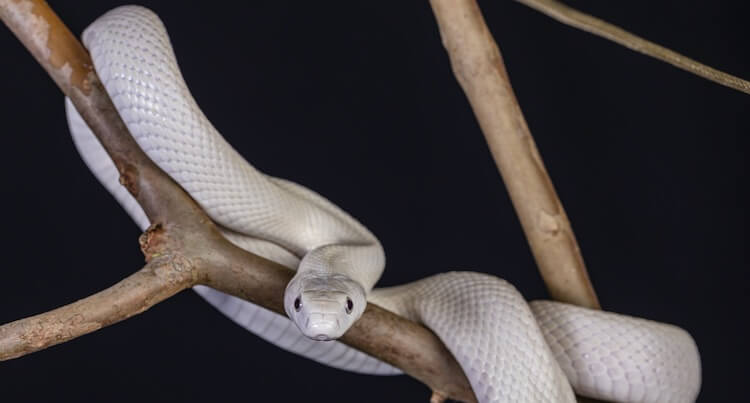
Leucistic Texas Rat Snakes are a popular morph bred from the standard Texas rat snake.
Some leucistic individuals have been found in the wild, however, it is more common for these morphs to be captive bred.
Leucistic snakes are pure white or light pink with glossy scales.
Unlike albino morphs that have no pigmentation, leucistic snakes retain the color in their eyes and have gray or golden irises.
| Vital Facts |
|---|
| Color: White or light pink |
| Pattern: None |
| Size: 3 to 5 feet |
| Classification: New world |
| Scientific Name: Elaphe obsoleta lindheimeri |
12. Japanese
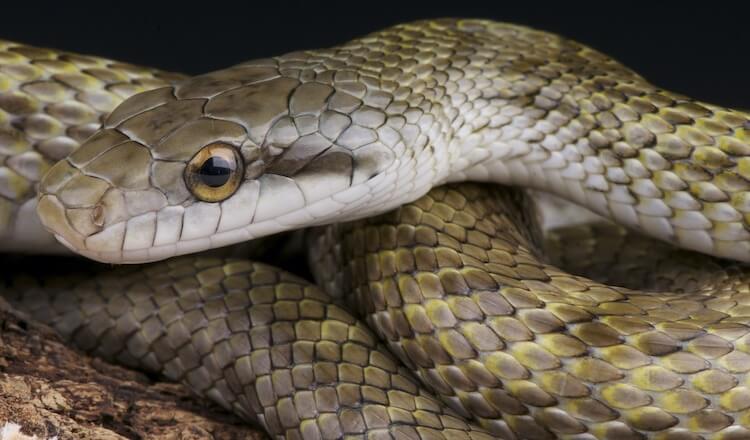
This type of rat snake is commonly found in the forests of Japan.
Japanese Rat Snakes are a medium-sized snake and hunt small rodents at dawn and dusk.
This snake has irregular patches of dark yellow and olive with a solid-colored green head and a black smudge through their eye.
Their belly scales are pale green or white with intermittent black speckles.
Interestingly there is a wild population of albino Japanese rat snakes near the city of Iwakuni. This wild population is protected by the Japanese government.
| Vital Facts |
|---|
| Color: Olive or yellowish green with pale underbelly |
| Pattern: Speckled black |
| Size: 3 to 5 feet |
| Classification: Old world |
| Scientific Name: Elaphe climacophora |
11. Brown
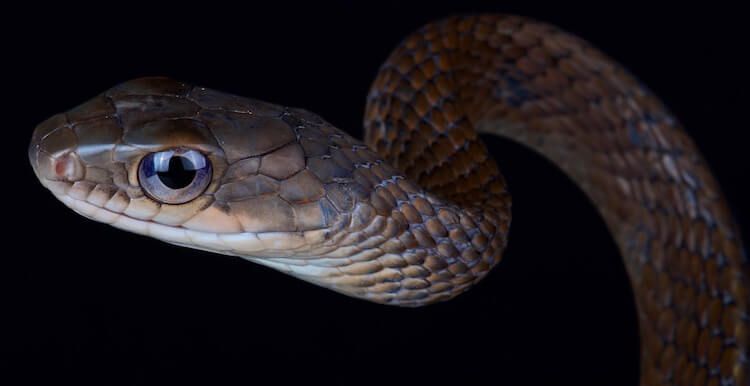
Brown Rat Snakes are a species of rat snake found in Sumatra, Thailand and Indonesia.
This species is often found near streams and rivers where it hunts lizards and small mammals.
They are longer and more graceful than other species in this list and have a habit of raising the front half of their body off the ground and swaying side-to-side when disturbed.
Young individuals are speckled with green and black. They become reddish-brown as they age.
Adults are dark brown or red with a black spiderweb patterns on their back and side.
| Vital Facts |
|---|
| Color: Dark brown or red with a white belly |
| Pattern: Thin black spiderwebs |
| Size: 5 to 8 feet |
| Classification: Old world |
| Scientific Name: Ptyas fusca |
10. Everglades Rat Snake
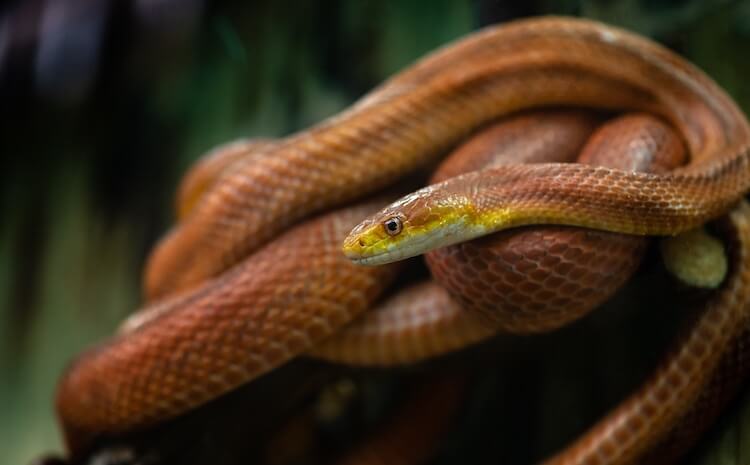
The Everglades Rat Snake is a member of the Eastern rat snake family.
As their name suggests this species is from the south Florida Everglades.
Everglades Rat snakes are a deep orange with a cream or yellow underbelly. Some individuals may show faint stripes down their backs but these are usually absent in mature adults.
Juveniles are very similar to other eastern rat snake subspecies.
They only develop the orange color as they age.
Everglades snakes are unique among other North American species as they are often found near water are quite good at swimming.
| Vital Facts |
|---|
| Color: Bright orange or yellow |
| Pattern: Possible faint stripes |
| Size: 3 to 6 feet |
| Classification: New world |
| Scientific Name: Elaphe obsoleta rossalleni |
9. Trans-Pecos
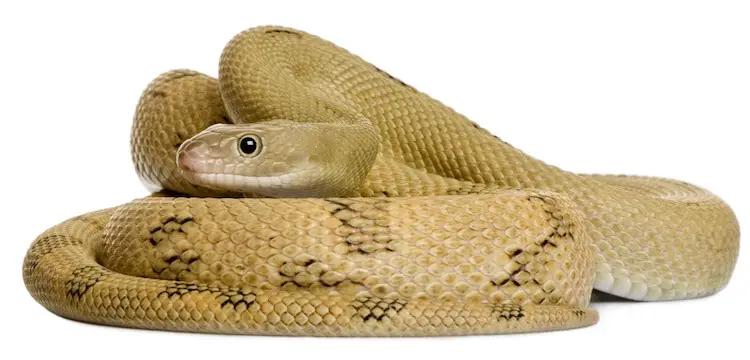
The Trans-Pecos rat snake is native to a small piece of land in southwestern Texas and northern Mexico.
Trans-Pecos are a slender rat snake that are olive-tan in color and have no head markings.
They have two black stripes down their neck that continue into a line of brown and black blotches with a light center. Some lighter individuals may not show any stripes.
Trans-Pecos rat snakes have similar cream-colored bellies to their cousin the Baja California.
This species is very docile and is commonly sold as a pet for $100 to $150.
| Vital Facts |
|---|
| Color: Yellow, olive or tan |
| Pattern: H-shaped markings along the spine |
| Size: 3 to 5 feet |
| Classification: New world |
| Scientific Name: Bogertophis subocularis |
8. Western Rat Snake
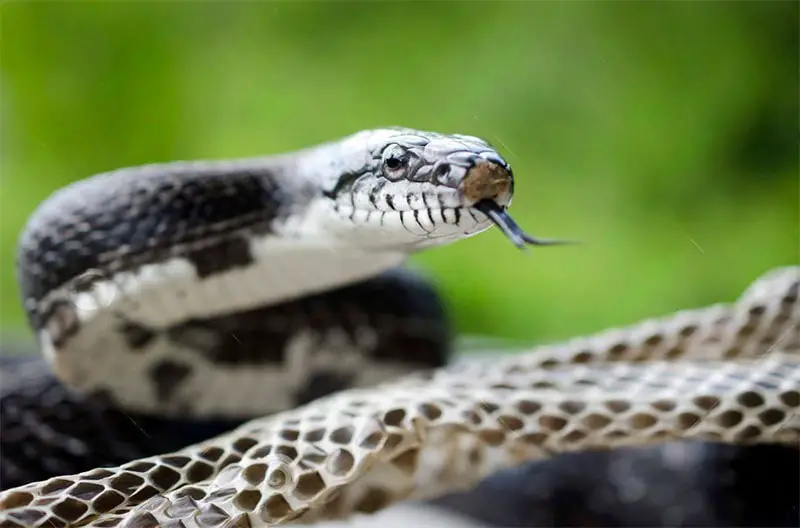
The Western Rat Snake is a black variety of rat snake.
Western rat snakes are found anywhere from north Texas to the Great Lakes and southern Canada.
This species is a dark reddish-brown with pale splotches that are ringed with black. They typically have a bright white chin and a pale tan belly with dark bands.
Their mottled appearance gives them a similar look to the timber rattlesnake. Because of their similar appearance this snake will rattle its tail in leaf litter to make a sound similar to a rattlesnake.
The Western snake is a popular pet rat snake and has very simple care needs.
| Vital Facts |
|---|
| Color: Dark red |
| Pattern: Dark rings with white in the middle down the spine |
| Size: 3 to 6 feet |
| Classification: New world |
| Scientific Name: Pantherophis obsoletus |
7. Great Plains
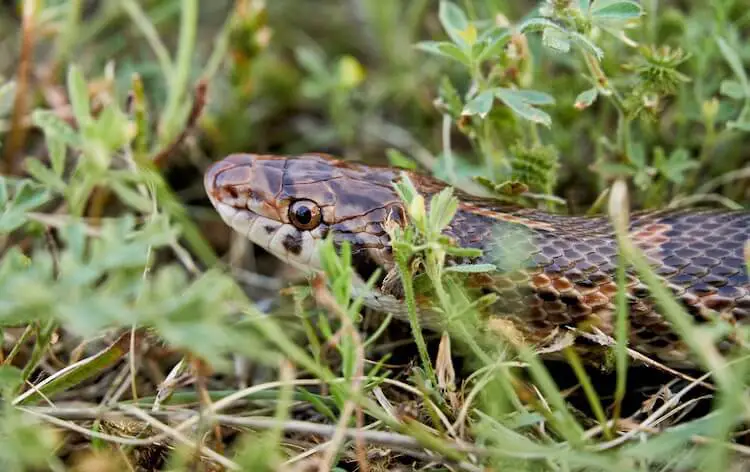
The Great Plains is a small rat snake native to Kansas, Oklahoma, Missouri, Texas and northern Mexico. Because this species is nocturnal it is rare to find them throughout their range.
This snake looks very similar to the red rat snake but is generally browner in color.
Great Plains have dark brown saddles down their back and smaller spots on their sides.
Their belly is light gray with a double row of stripes on the end of their tail.
| Vital Facts |
|---|
| Color: Gray or tan |
| Pattern: Dark brown saddles and spots on the side |
| Size: 2 to 3 feet |
| Classification: New world |
| Scientific Name: Pantherophis emoryi |
6. Gray Rat Snake
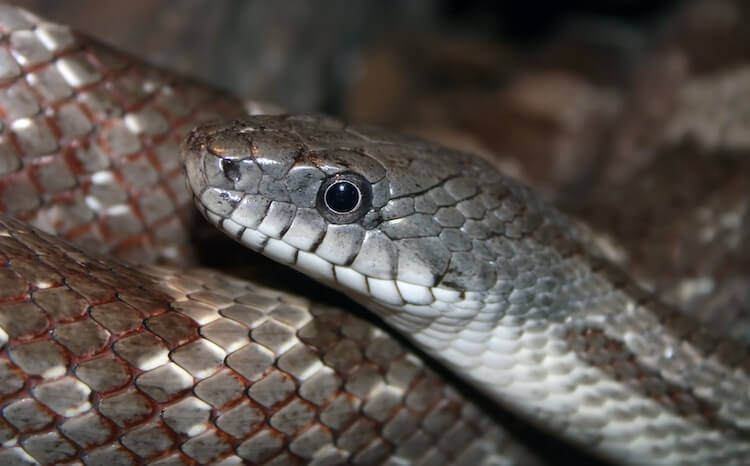
This species of rat snake is found in a strip of the United States east of the Mississippi river and west of the Appalachian mountains.
In the northern part of their range adults are a dark gray with black on their back and sides. In the southern part of its range this snake retains its juvenile markings. This results in a rat snake that has dark brown or gray saddle markings.
Gray rat snakes have very rough scales and have a larger keel than black rat snakes.
| Vital Facts |
|---|
| Color: Gray to black and a white belly |
| Pattern: Gray saddles |
| Size: 3 to 6 feet |
| Classification: New world |
| Scientific Name: Pantherophis spiloides |
5. Red Rat Snake
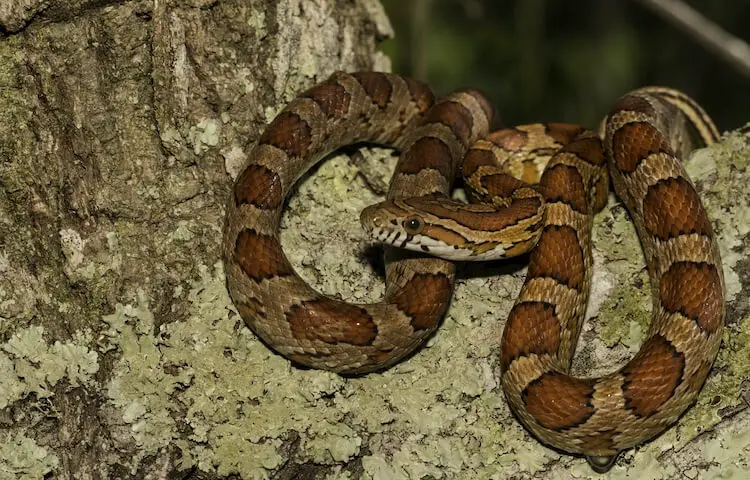
The red rat snake is another name for a corn snake.
Corn snakes are native to the southeast corner of the United States. They normally live near manmade structures like barns.
This species is smaller than most rat snakes in this list.
In the wild red rat snakes are bright tan or orange. They have dark red saddles down their backs and a distinct V-shape marking between the eyes.
Their bellies are a checkerboard of black and white squares. This is where they get their name as it looks like the kernels of flint corn.
| Vital Facts |
|---|
| Color: Orange, yellow, tan and red |
| Pattern: Dark red or brown saddles with a checkered belly |
| Size: 1.5 to 3 feet |
| Classification: New world |
| Scientific Name: Pantherophis guttatus |
4. Yellow Rat Snake
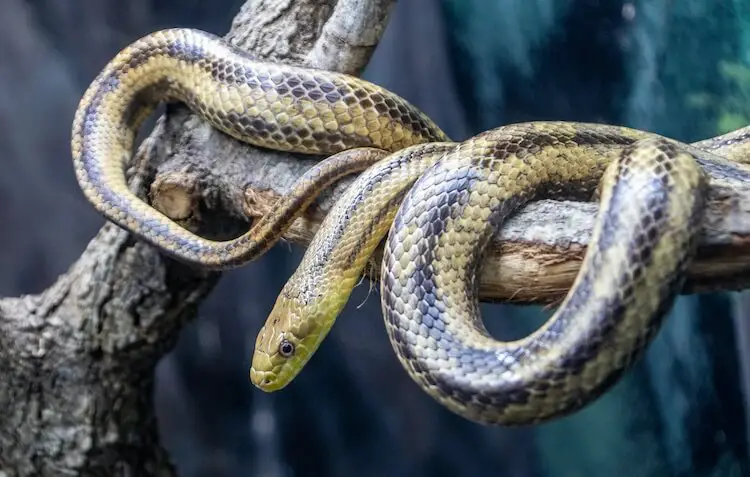
Yellow Rat Snakes are a subspecies of the Eastern rat snake.
The yellow rat snake is a beautiful golden or olive color with four dark brown stripes down its spine.
These stripes may be strikingly dark or almost invisible depending on the individual.
Yellow Rats also have a smooth white or yellow belly without any markings and golden irises.
The yellow rat snake is a very popular pet that has also been bred for a variety of morphs. The most popular morphs include:
- Albino
- Patternless
- Whiteside
| Vital Facts |
|---|
| Color: Yellow or olive white belly |
| Pattern: 4 stripes from head to tail |
| Size: 3 to 6 feet |
| Classification: New world |
| Scientific Name: Pantherophis alleghaniensis quadrivittata |
3. Eastern Rat Snake
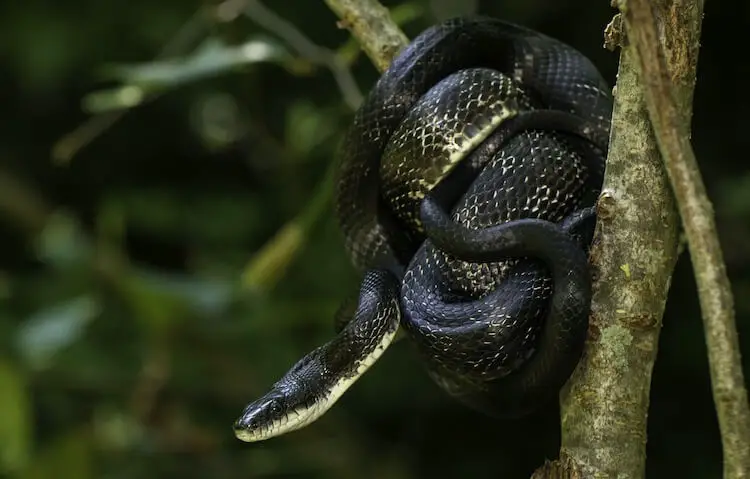
Eastern Rat Snakes are found exclusively along the southeastern coast of the United States.
It is common to find them anywhere from North Carolina to Florida.
They are almost identical to a black rat snake as the is completely black on the back and sides with small keels on their scales.
Juveniles are light gray with darker brown squares along their spine. These markings fade as they age.
Their underbelly is white towards the chin and has irregular black spots that merge together into a solid gray near the tail.
| Vital Facts |
|---|
| Color: Black, gray with a white belly |
| Pattern: Black checkerboard on the stomach |
| Size: 3 to 6 feet |
| Classification: New world |
| Scientific Name: Pantherophis alleghaniensis |
2. Texas Rat Snake
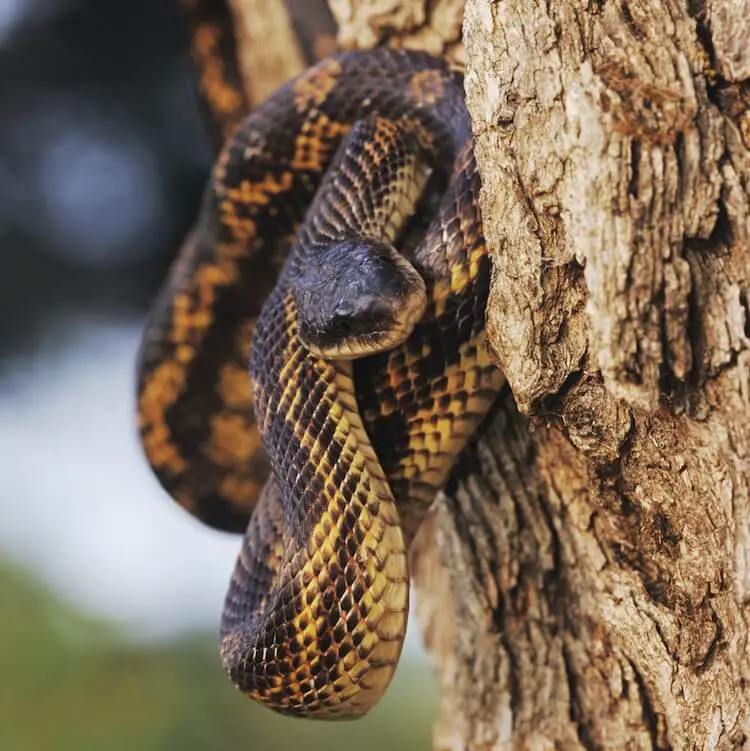
Texas Rat Snakes are commonly found in Texas and the surrounding states.
Depending on where you find this snake will depend on their appearance.
Individuals from eastern Texas are typically dark reddish gray.
Species from central Texas are more yellow.
The basic pattern of this snake is always the same. Texas Rat Snakes have dark hexagonal blotches along the spine and a pale cream belly with few markings. They also have red skin between their scales that is clearly visible after they have eaten.
These snakes are often confused with copperheads because of their appearance.
| Vital Facts |
|---|
| Color: Reddish brown |
| Pattern: Hexagonal back spots |
| Size: 3 to 6 feet |
| Classification: New world |
| Scientific Name: Elaphe obsoleta lindheimeri |
1. Black Rat Snake
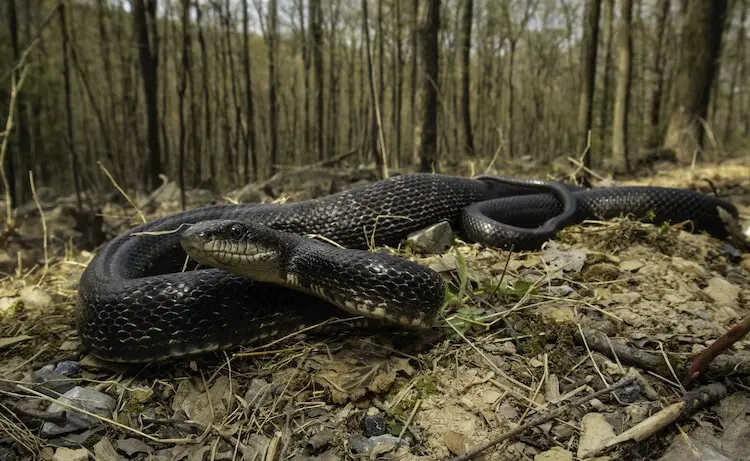
Black Rat Snakes are one of the most popular species of rat snake in North America.
They make excellent pets and are very docile.
Black rats are easily identified by their shiny black scales and white belly scales with patches of black.
This species is one of the largest in North America with some individuals reaching six feet.
They are native to the Eastern United States and can be purchased for $50.
| Vital Facts |
|---|
| Color: Black and white |
| Pattern: Solid black on top and a white belly |
| Size: 3 to 6 feet |
| Classification: New world |
| Scientific Name: Pantherophis obsoletus |
Choosing A Rat Snake
Not every type of rat snake is suitable for every owner.
The species you choose will depend on your husbandry ability and what you are looking for.
The King and Red-tailed green species are fairly aggressive and so are not suitable for beginners.
Black, Eastern, Texas, Yellow, Gray, Western and Trans-Pecos species when captive bred have calm personalities and are easy to manage for experienced hobbyists.
Japanese, Red, Rhino, and Mexican rat snakes are the best for beginners. These four species are relatively small, docile and have unique and variable patterns and colors.
Have you decided to adopt a rat snake? Let us know in the comments.


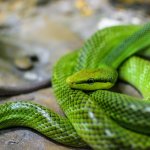
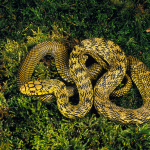

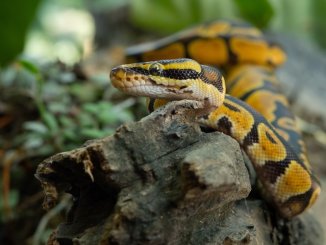
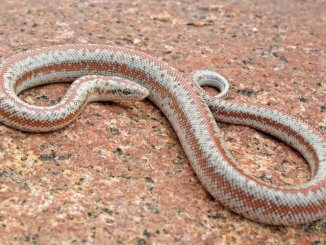
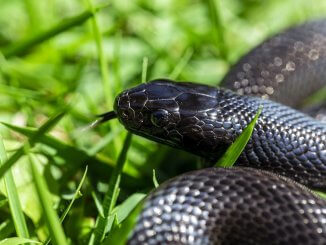

I adopted a white sided black rat snake. She is beautiful and shy. She doesn’t like an audience when she eats, but hasn’t missed a meal. They are highly underrated as pets.